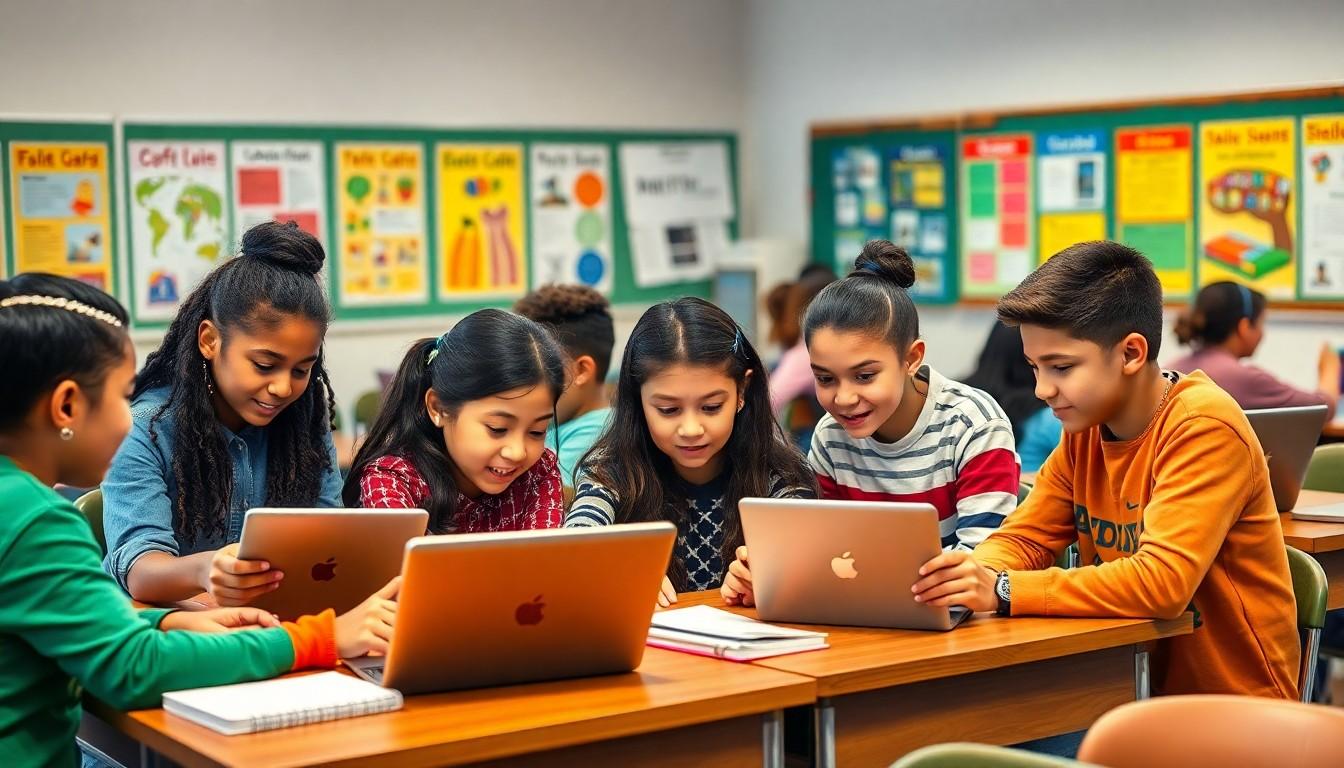Phone:
(701)814-6992
Physical address:
6296 Donnelly Plaza
Ratkeville, Bahamas.

In today’s fast-paced world, K-12 education technology companies are shaking things up in the classroom like a soda can on a rollercoaster. With innovative tools and platforms at their fingertips, educators are transforming the way students learn, making education more engaging and accessible than ever. Gone are the days of boring textbooks and chalkboards—now it’s all about interactive apps and virtual classrooms that make learning feel like an adventure.
K-12 education technology companies focus on developing tools and resources specifically tailored to the needs of students and educators. These enterprises create solutions that enhance learning environments through innovative products like online resources, learning management systems, and interactive applications. Examples of such companies include Google for Education, which provides collaborative tools for classrooms, and Kahoot!, known for its engaging quiz-based learning platform.
Market trends indicate a significant shift toward personalized learning experiences. Companies like DreamBox Learning offer adaptive math programs that adjust in real time to meet individual student needs. Another example, Seesaw, allows for portfolio management and communication between teachers, students, and parents, fostering collaboration.
Investment in K-12 education technology soared, reaching nearly $2 billion in 2021 alone. This surge highlights the growing importance of tech in education. Startups contribute to this landscape by introducing niche products that address specific challenges, such as remote assessment tools from ExamSoft.
Targeting educators and school districts, these companies often provide professional development resources. Companies like Edmodo focus on creating social learning networks that facilitate teacher collaboration and resource sharing.
Advancements in artificial intelligence and data analytics further enhance the capabilities of these tools. AI-powered platforms, such as Squirrel AI, offer personalized tutoring to support students beyond traditional classroom instruction. Additionally, big data helps track student performance, enabling targeted interventions.
Overall, K-12 education technology companies play a crucial role in transforming educational practices, making learning more interactive and accessible for diverse student populations.

K-12 education technology companies include a diverse range of established and emerging players, each contributing to innovative educational practices.
Google for Education, a leader in educational technology, provides tools like Google Classroom and G Suite for seamless collaboration among teachers and students. Microsoft Education offers similar services through Teams and OneNote, enhancing communication. Companies like Pearson integrate digital content with traditional publications, meeting varying educational needs. Kahoot! transforms learning through gamified assessments, making engagement fun and effective. Additional contributions come from Learning A-Z, which provides diverse literacy resources tailored for various reading levels. These established organizations significantly influence K-12 education, making technology accessible and beneficial for educators and students alike.
Innovative startups are reshaping K-12 education technology with fresh approaches and solutions. DreamBox Learning focuses on personalized mathematics education, adapting content to meet individual student requirements. Seesaw, a student engagement platform, fosters collaboration between students and families through digital portfolios. Companies like ExamSoft introduce specialized tools for remote assessments, addressing unique challenges in modern education. Squirrel AI leverages artificial intelligence to deliver customized tutoring experiences based on student performance data. These emerging startups create dynamic learning environments, offering targeted resources that satisfy contemporary educational demands.
Innovative technologies significantly enhance K-12 education, transforming traditional teaching methods into dynamic learning experiences. Numerous tools cater to diverse educational needs, focusing on engagement and personalized learning.
Learning management systems streamline classroom activities by organizing educational content in digital formats. Various platforms, such as Google Classroom and Canvas, simplify assignment distribution and grading processes. Teachers benefit from integrated features that support communication with students and parents. Administrators gain valuable insights through analytics capabilities. As educational institutions place a premium on efficiency, these systems have become essential resources in modern learning environments.
Adaptive learning tools personalize student experiences based on individual learning paces and styles. Companies like DreamBox Learning and IXL Learning utilize algorithms to tailor lessons according to performance. Engagement increases as students receive real-time feedback, which boosts their confidence and motivation. These adaptive technologies showcase a commitment to personalized education, addressing the specific needs of each learner. Having flexibility proves crucial in fostering academic success for diverse classroom populations.
Technology significantly transforms K-12 education, enhancing both student engagement and access to learning resources.
Interactive platforms foster deep engagement among students. Personalized learning pathways enable tailored educational experiences for diverse learning styles. Tools like gamified assessments promote motivation and retention of knowledge. Instant feedback from adaptive technologies boosts confidence and helps identify areas for improvement. Increased accessibility ensures that all students, regardless of location, can access quality education. Collaboration through platforms encourages peer engagement and teamwork, nurturing essential communication skills. These elements combined create a dynamic learning environment that prepares students for future challenges.
Integrating technology into classroom settings presents several challenges for educators. Ensuring equity of access to devices and internet connectivity remains a critical issue. Training teachers to effectively use these tools requires ongoing professional development and support. Managing diverse learning needs in one classroom can complicate lesson planning. Additionally, keeping up with rapid technological advancements demands continuous adaptation. Monitoring student engagement and understanding through technology can also be difficult. Balancing traditional instructional methods with new tools is essential for a seamless educational experience.
K-12 education technology continuously evolves, with several exciting trends shaping the future of learning environments.
AI and machine learning gain traction in K-12 education, leading to more personalized learning experiences. Tools powered by artificial intelligence analyze student data to create tailored learning paths. Real-time feedback allows educators to adapt instructional strategies to individual needs. Companies like Squirrel AI prioritize customization, ensuring students receive support based on their unique strengths and weaknesses. Predictive analytics enhance lesson planning by identifying areas where students struggle. Personalized tutoring solutions create opportunities for skill development outside the traditional classroom setting. With rising investments, the integration of AI tools displays a strong commitment to enhancing student outcomes through data-driven insights.
Virtual and augmented reality redefine the learning landscape for K-12 students. Immersive experiences foster engagement by transporting learners to different environments, enhancing contextual understanding. As educational content transforms, platforms like Nearpod and Google Expeditions enable interactive field trips and simulations. These technologies support diverse learning styles while promoting collaboration among students. Educators use VR to illustrate complex concepts, making abstract themes more tangible. With the potential to practice skills in safe settings, students build confidence and competencies without real-world risks. The growth of VR and AR signals a shift towards experiential learning, offering innovative ways to experience education firsthand.
K-12 education technology companies are reshaping the landscape of learning. Their innovative tools and platforms not only enhance engagement but also ensure accessibility for all students. As the industry evolves with advancements in artificial intelligence and immersive technologies, the potential for personalized learning experiences continues to grow.
These companies are vital in bridging the gap between traditional education and modern demands. By fostering collaboration and adapting to individual needs, they prepare students for future challenges while supporting educators in their journey. The commitment to improving educational practices through technology is a promising sign for the future of K-12 education.